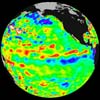| . |  |
. |
A remarkable expedition to the waters of Antarctica reveals that iron supply to the Southern Ocean may have controlled Earth's climate during past ice ages. A multi-institutional group of scientists, led by Dr. Kenneth Coale of Moss Landing Marine Laboratories (MLML) and Dr. Ken Johnson of the Monterey Bay Aquarium Research Institute (MBARI), fertilized two key areas of the Southern Ocean with trace amounts of iron. Their goal was to observe the growth and fate of microscopic marine plants (phytoplankton) under iron-enriched conditions, which are thought to have occurred in the Southern Ocean during past ice ages. They report the results of these important field experiments (known as SOFeX, for Southern Ocean Iron Enrichment Experiments) in the April 16, 2004 issue of Science. Previous studies have suggested that during the last four ice ages, the Southern Ocean had large phytoplankton populations and received large amounts of iron-rich dust, possibly blown out to sea from expanding desert areas. In order to simulate such ice-age conditions, the SOFeX scientists added iron to surface waters in two square patches, each 15 kilometers on a side, so that concentrations of this micronutrient reached about 50 parts per trillion. This concentration, though low by terrestrial standards, represented a 100-fold increase over ambient conditions, and triggered massive phytoplankton blooms at both locations. These blooms covered thousands of square kilometers, and were visible in satellite images of the area. Each of these blooms consumed over 30,000 tons of carbon dioxide, an important greenhouse gas. Of particular interest to the scientists was whether this carbon dioxide would be returned to the atmosphere or would sink into deep waters as the phytoplankton died or were consumed by grazers. Observations by Dr. Ken Buesseler of Woods Hole Oceanographic Institution and Dr. Jim Bishop of Lawrence Berkeley National Laboratories (reported separately in the same issue of Science) indicate that much of the carbon sank to hundreds of meters below the surface. When extrapolated over large portions of the Southern Ocean, this finding suggests that iron fertilization could cause billions of tons of carbon to be removed from the atmosphere each year. Removal of this much carbon dioxide from the atmosphere could have helped cool the Earth during ice ages. Similarly, it has been suggested that humans might be able to slow global warming by removing carbon dioxide from the atmosphere through a massive ocean fertilization program. Unlike previous iron fertilization experiments, SOFeX focused on the two different parts of the Southern Ocean to determine if the iron-induced blooms would be influenced by variations in silicic acid concentrations. Silicic acid is essential to the growth of diatoms, a common type of phytoplankton. The southern part of the Southern Ocean typically has an abundance of silicic acid but the northern part often has very low levels. The results of this experiment indicate that even where silicic acid levels are low, iron fertilization can result in blooms of phytoplankton such as dinoflagellates and prymneseophytes, which do not require silicon for growth yet still consume vast amounts of carbon dioxide. This finding has doubled the area of the Southern Ocean that scientists believe could be important for carbon cycling. The SOFeX experiment was carried out during January and February of 2002, after a decade of planning and preparation, and was funded by the US National Science Foundation and the US Department of Energy. It involved two US research vessels from Scripps Institution of Oceanography and one US Coast Guard research ice-breaker, as well as about 100 scientists from at least eighteen different research institutions. This important experiment is covered in three research articles in the April 16 issue of Science, and is featured on the magazine's cover. Related Links Woods Hole Oceanographic Institution SOFeX Cruise Iron Fertilization Why Dump Iron in the Ocean? Cafe Thorium 1999 Cruise Results SpaceDaily Search SpaceDaily Subscribe To SpaceDaily Express  New York - Apr 15, 2004
New York - Apr 15, 2004For scientists studying climate change, the past is often a key to understanding the future. Dake Chen at Columbia University's Lamont-Doherty Earth Observatory recently used more than a century of climate data to successfully test an improved model of ENSO, the El-Ni�o/Southern Oscillation that scientists believe is behind climate change in many parts of the world.
|
| ||||||||||
| The content herein, unless otherwise known to be public domain, are Copyright 1995-2016 - Space Media Network. All websites are published in Australia and are solely subject to Australian law and governed by Fair Use principals for news reporting and research purposes. AFP, UPI and IANS news wire stories are copyright Agence France-Presse, United Press International and Indo-Asia News Service. ESA news reports are copyright European Space Agency. All NASA sourced material is public domain. Additional copyrights may apply in whole or part to other bona fide parties. Advertising does not imply endorsement, agreement or approval of any opinions, statements or information provided by Space Media Network on any Web page published or hosted by Space Media Network. Privacy Statement All images and articles appearing on Space Media Network have been edited or digitally altered in some way. Any requests to remove copyright material will be acted upon in a timely and appropriate manner. Any attempt to extort money from Space Media Network will be ignored and reported to Australian Law Enforcement Agencies as a potential case of financial fraud involving the use of a telephonic carriage device or postal service. |